Dwarf Fruit Trees to Grow Indoors or Outdoors with Pictures and Identification Guide
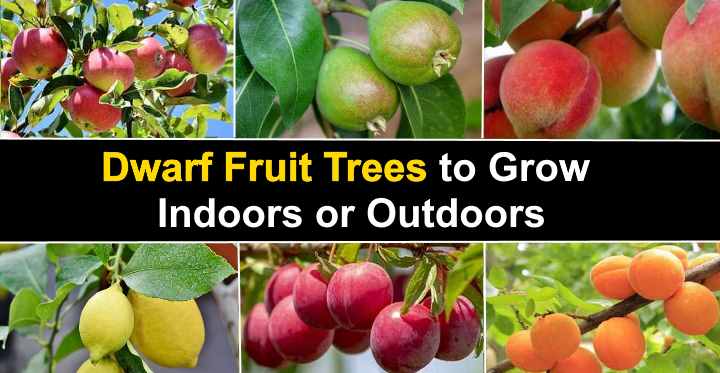
Dwarf fruit trees are the perfect choice to grow fruit in small, confined spaces. Dwarf and miniature fruit trees can grow in containers on balconies, patios, decks, or in small backyards. Dwarf apple, pear, plum, and cherry trees produce fragrant, colorful blossoms in spring. This is followed by fruit from the trees in the summer or fall. You can also find types of citrus, apricot, and peach trees that are dwarf cultivars.
It is much easier to manage dwarf fruit trees in a small garden or yard. Varieties of dwarf trees that produce fruit are generally between 6 and 8 ft. (1.8 – 2.4 m) tall. These small plants take up much less space in a garden than a standard 30-ft. (9-m) fruit tree. Many miniature fruit trees also grow well in containers indoors. So, in your porch or living room, you could grow small orange, lime, or even fig trees.
Although the size of the trees is smaller, most of the fruit they produce is the same as regular fruit trees.
In this article, you will learn about the best dwarf trees to grow where space is limited. We will look at both indoor and outdoor varieties of small, compact, dwarf fruit trees. You will also find out about the best way to care for dwarf fruit trees.
What Are Dwarf Fruit Trees?
Fruits trees that grow in pots, containers, or buckets are developed by grafting a fruit tree onto a dwarfing root-stock. This produces trees that don’t grow tall but produce standard-size apples, pears, plums, or other fruit.
In outdoor gardens, dwarf trees don’t usually grow taller than 8 ft. (2.4 m). Most dwarf cultivars need a space less than 8 ft. (2.4 m) to thrive, and some require even less room. So, it’s entirely possible to grow a small fruit tree indoors on a patio or balcony.
Another feature of miniature fruit trees and dwarf cultivars is that they mature quicker. You get to enjoy the “fruits of your labor” a few years earlier than from standard fruit trees.
How to Choose a Dwarf Fruit Tree
Even if you don’t plan on growing dwarf fruit trees indoors or on a patio, they are still an excellent choice for any size of yard. Small fruit trees are easier to prune. You can also create ornamental fruit shrubs or trees to create an attractive feature in your yard.
Fruit trees that grow well in pots are not stuck in one place in your garden. So, if you have trees growing in pots or containers, you can easily move them to other parts of your landscaped garden.
How can you pick the right fruit tree for your patio, balcony, or compact yard?
If space is limited, you should decide on how many fruit trees you want. Some dwarf fruit trees, such as cherry, peach, and apricot, are self-fertile. So, you only need one tree to get a bumper crop of fruit. Other trees such as small apple and pear trees need another similar tree close by for pollination. If you can only have room for one dwarf fruit tree, look for a “family” tree. This has 2 or 3 varieties of trees grafted onto one dwarfing root-stock.
How to Plant and Grow Small Fruit Trees
Growing dwarf fruit trees is similar to growing any kind of fruit-producing tree. Good soil, plenty of sunshine, and enough moisture are the main requirements. However, there are a few specifics when it comes to growing fruit trees in pots.
Pots for fruit trees

Choose a large pot for your dwarf or miniature fruit tree
The minimum size of pot or container to grow fruit trees indoors or outdoors is 1 ft. by 1 ft. (30 cm by 30 cm). This container should be sturdy enough to keep a fruit tree stable. Because all dwarf fruit trees need well-draining soil, make sure that your growing pot has holes in the bottom. You can increase drainage by adding a layer of clay pebbles on the bottom.
You can be inventive with your container because plastic buckets or galvanized dustbins are ideal for small trees. Choose elegant terracotta pots or rustic wooden barrels if you want to have a more attractive pot for your fruit tree.
The best soil for fruit trees in containers
Small apple, pear, citrus, and other fruit trees need a soil-based potting mix. This ensures that nutrients are released slowly and produce healthy fruit. Make sure you place your pot in a sunny place so the fruit tree can get plenty of warm sunshine.
Dwarf, miniature, and small fruit trees need at least 6 hours of sunshine daily.
How to water fruit trees in pots
During the growing season from spring until late summer, you should keep your small trees well-watered. Adding a layer of mulch can help to retain moisture and prevent the soil from drying out during summer.
Feeding your fruit-producing dwarf tree
Any type of fruit tree needs the proper nutrients, and small, miniature fruit trees are no exception. The best time to add fertilizer to your pot or container is when the tree buds are about to break out. You can use fertilizer up until mid-June, but no later.
Use nitrogen-rich, organic fertilizers that are specially produced for fruit trees.
Dwarf Fruit Trees
Let’s look in more detail at the many types of dwarf fruit tree cultivars that grow indoors or outdoors in containers. These small trees are also perfect for planting directly in the soil if you want to have a specimen fruit tree or grow a mini fruit orchard.
Dwarf Apple Trees
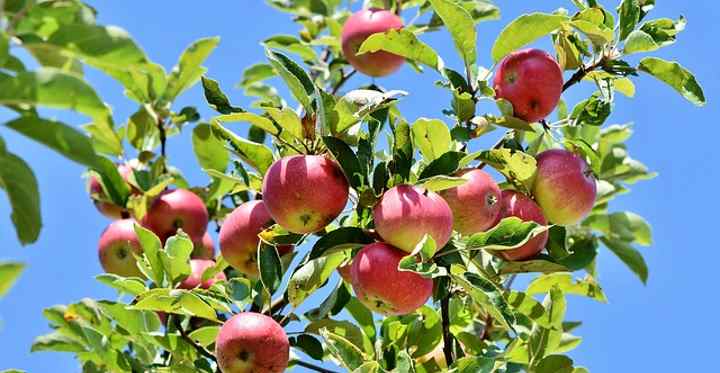
There are many dwarf apple tree cultivars to choose from
Dwarf apple trees (Malus domestica) are the easiest type of fruit tree to grow in small yards or containers. Depending on the dwarf cultivar, apple trees grow to between 3 ft. and 8 ft. (0.9 – 2.4 m) tall. Usually, you need to have at least 2 small apple trees to ensure pollination.
One of the beauties of growing dwarf apple trees is that they are incredibly hardy. Popular cultivars such as ‘Honeycrisp,’ ‘Goodland,’ ‘Northern Lights,’ and ‘Blonde’ grow well in USDA hardiness zones 3 to 6.
When it comes to choosing a dwarf apple variety, there are hundreds to choose from.
Crabapples are another species of apple tree that is naturally small. Some dwarf crabapple cultivars grow to 6 ft. (1.8 m) tall and produce white or purple flowers in spring.
For added beauty, you can look for columnar apple trees, weeping dwarf apple trees, or small shrub-like trees.
Indoor apple trees
If you are thinking of growing an apple tree on your porch, choose one of the ultra-dwarf varieties. Growing to between 3 and 6 ft. (0.9 – 1.8 m) tall, these container fruit trees can grace a bright indoor area or patio. If the apple tree doesn’t produce fruit after 3 years or so, you may have to move the pot outdoors. You will need to look for a self-pollinating variety.
Dwarf Pear Trees
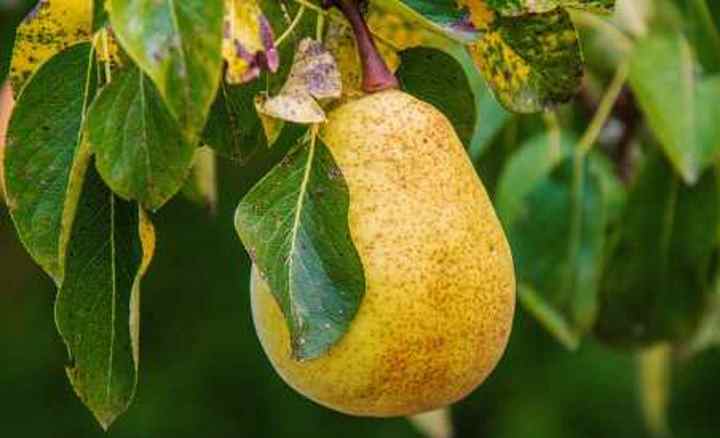
Dwarf pear tree varieties are easy to grow in a small yard
Dwarf pear trees (Pyrus) come in columnar, small tree, and bush varieties. These are the perfect cultivars if you want to grow a potted fruit tree in a compact yard or balcony. Similar to apples, pear fruit trees are cold-hardy.
However, all pear trees are susceptible to frost damage that kills the early seasonal flowers. So, you may need to cover budding branches if there is frost. Or, you could bring the container into a sheltered area indoors until the weather gets better.
Being a small tree under 8 ft. (2.4 m) with a spread of 6.5 ft. (2 m), it is straightforward to care for dwarf pear trees. You can plant a few together to create a fruit-producing border or use it as a specimen tree.
For small gardens and backyards, choose a dwarf bush, cordon, stepover, or pyramid pear tree cultivar. Some good dwarf pear trees include ‘Ure,’ ‘Golden Spice,’ ‘Pattern,’ and ‘Parker.’
Dwarf Lemon Trees
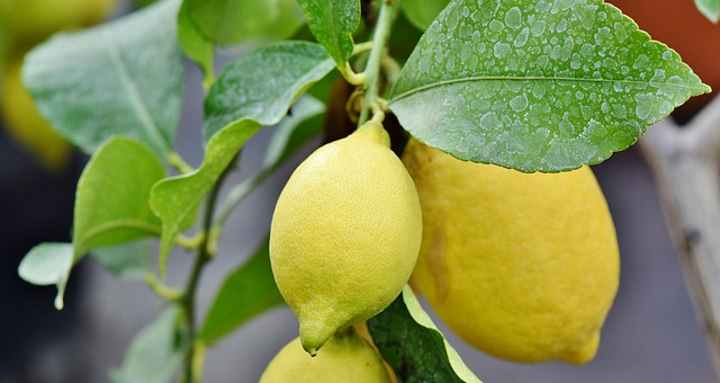
Dwarf lemon trees are self-pollinating and are best grown in full sun in free draining soil
Lemons (Citrus limon) are a perfect choice if you want to grow container citrus fruit trees. The most popular type of lemon tree for pots is the dwarf ‘Meyer’ cultivar.
Dwarf lemon trees are self-pollinating varieties if you want to grow just one in a small space. The yellow citrus fruit has a tangy, citrusy taste and yellow rind. If you live in USDA zones 9 or 10, then lemon trees will grow well in a sunny garden. The bright yellow fruits provide beautiful summer colors against the dark green foliage.
Growing indoor lemon trees
Although lemons grow best outdoors, they can also be an indoor citrus fruit tree. You will need to make sure that the lemon tree is near a window that gets plenty of sunshine. A dwarf citrus tree needs at least 8 hours of sun daily. You will need to keep the soil moist but not too damp and make sure that plenty of air circulates the tree. You will also need to mist your tree regularly to ensure proper humidity.
Miniature Orange Trees
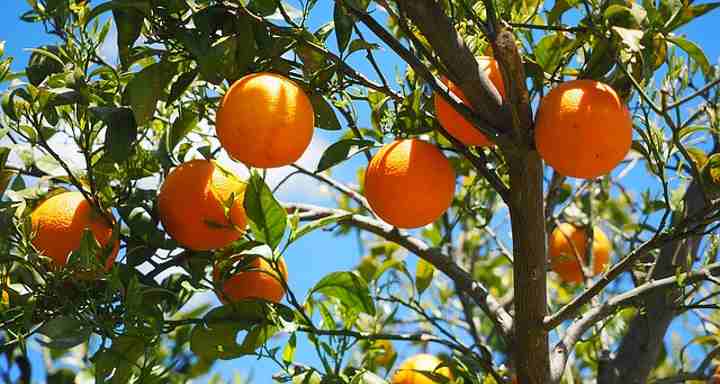
Dwarf orange trees require warm temperature and plenty of sun
Planting a small orange tree in a terracotta pot can bring a touch of the Mediterranean to any garden landscape. Dwarf orange trees require warm temperature and moist soil, and can grow well indoors or in small outdoor spaces if they have plenty of full sun.
If you want to grow small orange trees in a small garden, you should be in zones 8 – 11. If you live in colder climates, or if there is a danger of frost, miniature orange trees should be brought indoors or need to be covered with a large sheet or cloth.
Dwarf indoor orange trees
As an ornamental indoor plant, you can’t beat a dwarf orange tree. The fragrant flowers, tiny citrus fruits, and green foliage add décor and beauty to any room.
Dwarf Lime Trees

Dwarf Tahiti Bears lime is a popular lime suitable for container growing
Lime trees (Citrus × latifolia) grown from a dwarfing root-stock stay at a manageable height. The best type of dwarf lime cultivar is the Bears or Persian lime tree.
Apart from the lime-green citrus fruits, the beauty of dwarf lime is their small size. Most dwarf cultivars don’t grow any higher than 2 ft. (0.6 m) and produce several tasty fruits every year.
Dwarf lime trees grow outdoors in zones 9 to 11.
Indoor lime trees
You can also grow lime trees as an indoor houseplant. For best results, follow the same instructions for growing indoor lemon trees.
Dwarf Plum Trees
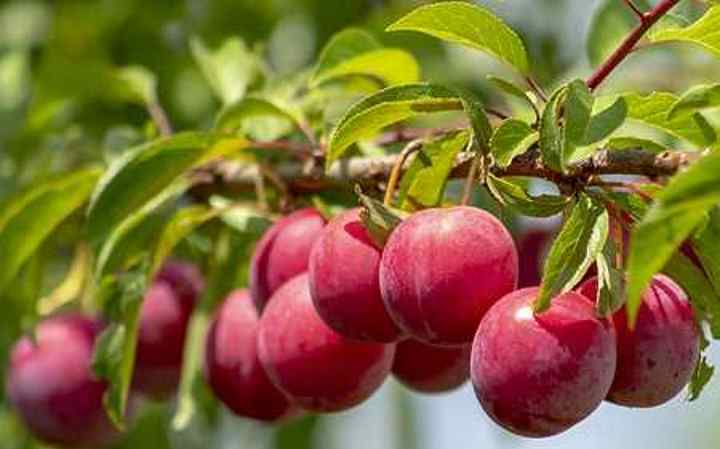
Potted dwarf plum trees are suitable for compact spaces
Another popular variety of potted fruit trees is plums (Prunus). Depending on the dwarf cultivar, potted plum trees can grow in various USDA zones. For example, the cold-hardy beach plum grows well in zones 3 – 6. The natal plum is a small shrub that thrives in zones 9 to 11.
Other popular varieties of small plum trees include ‘Johnson,’ ‘Damson’ plums, ‘Stanley,’ and ‘Methley.’ These little fruit trees grow well in large pots and can grow up to 8 ft. (2.4 m) tall.
Dwarf Peach Trees
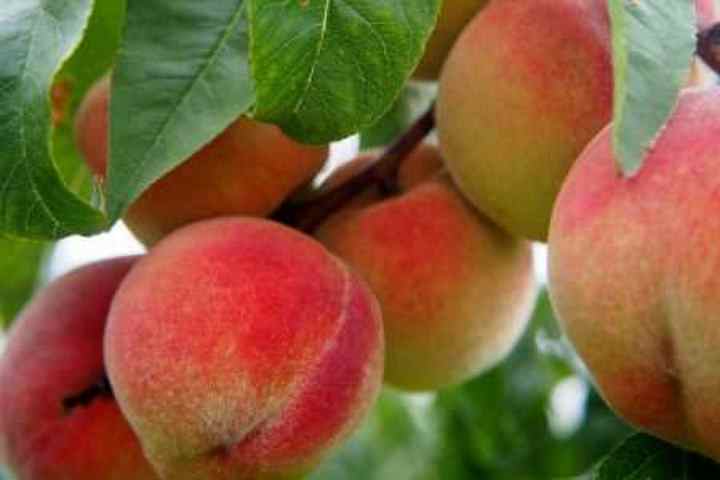
Dwarf peach tree is self-pollinating fruit tree
Dwarf peach trees (Prunus persica) are perfect for containers and balconies or to brighten up patios and small gardens. These dwarf potted fruit trees produce stone fruits that are firm, sweet, and juicy. Like most fruit trees in the Prunus genus, small peach trees are self-pollinating. So, if space is limited, you can plant just one.
Despite being associated with warm countries, peach trees are quite hardy. For example, the dwarf peach cultivars such as ‘Belle of Georgia’ and ‘Bonanza’ grow in zones 5 to 8. The white or pink blossoms brighten up spring gardens before producing delicious fruit in mid- to late-summer.
Dwarf Apricot Trees
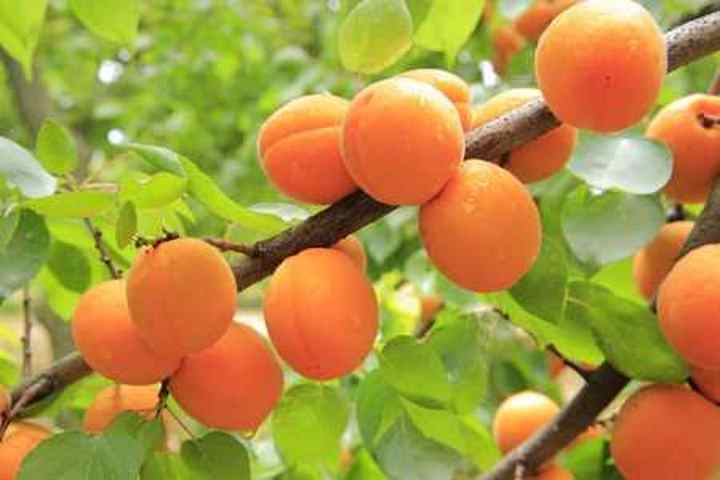
Dwarf apricot trees can be grown in pots in a sunny place
Similar to peach trees, dwarf apricot trees (Prunus armeniaca) grow well in containers and don’t take up much space in a small backyard. As a potted fruit tree, you should grow apricots in a sunny position in your garden.
Keep the soil moist, but well-drained if you want a good crop of yellowish-orange fruits.
Apricot trees grow well in zones 5 – 9, they are self-fertile, and the dwarf varieties grow up to 8 ft. (2.4 m) high.
Dwarf Cherry Tree
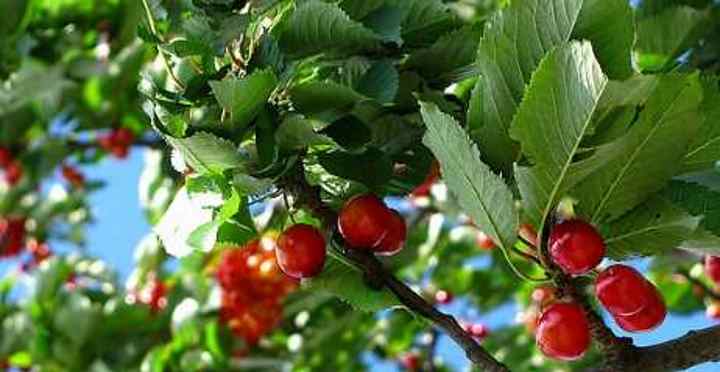
Dwarf cherry tree produces beautiful blossom to grace a small garden
Another excellent small fruit tree for a compact garden is dwarf cherry trees. The dwarf varieties are a good choice if your small backyard doesn’t get much sun.
Apart from clusters of red fruits, one reason to grow dwarf and semi-dwarf cherry trees is for their spectacular blossom. Because of their height, dwarf cherry trees may not be suited to growing in containers. Cold-hardy dwarf cultivars such as ‘Morello,’ ‘North Star,’ and ‘Meteor’ grow to between 8 and 10 ft. (2.4 – 3 m). However, because they are self-fertile, you only need to plant one in your garden.
Most small cherry trees grow well in zones 4 – 8 and can grow in shady locations. The fruit of these dwarf trees are usually bright red and have a sour taste.
Dwarf Fig Trees
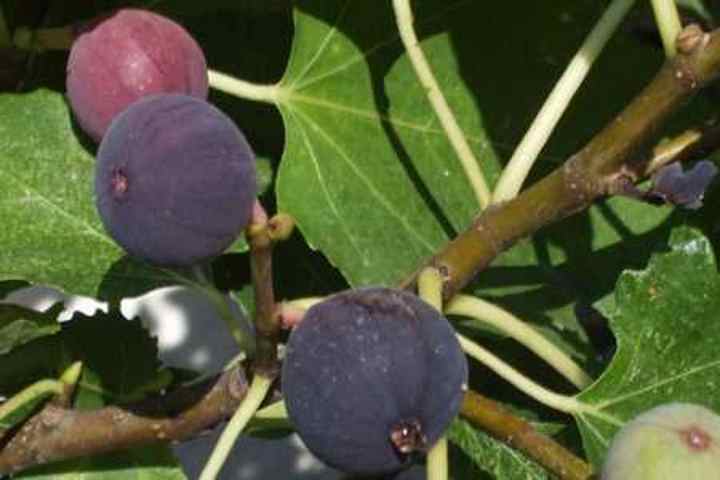
Dwarf fig tree can be grown indoors in colder climate or outdoors when the weather is warmer
Dwarf fig trees (Ficus carica) grow well in buckets and containers and can be pruned regularly to keep their height down. The best dwarf cultivars to produce sweet edible fruit are ‘Celestial’ or ‘Brown Turkey.’
If you live in USDA zones 8 to 11, you can grow figs in your container outdoors throughout the year. Growing potted fig plants is also ideal in temperate climates. You can grow the fig tree indoors during colder months and then transfer it outdoors in summer.
Dwarf Pomegranate Tree

Choose a small variety of pomegranate tree if space is limited
Pomegranate trees (Punica granatum) also come in smaller varieties that are perfect as a patio fruit tree or to brighten up a small garden. If space is limited or you want to grow pomegranates in a pot, choose one of the self-pollinating bushy cultivars.
The Punica granatum ‘Nana’ cultivar is a small bush-like tree that grows between 2 and 4 ft. (0.6 – 1.2 m) tall. It produces small sour pomegranate fruits and grows well in zones 7 – 11.
Dwarf Banana Tree
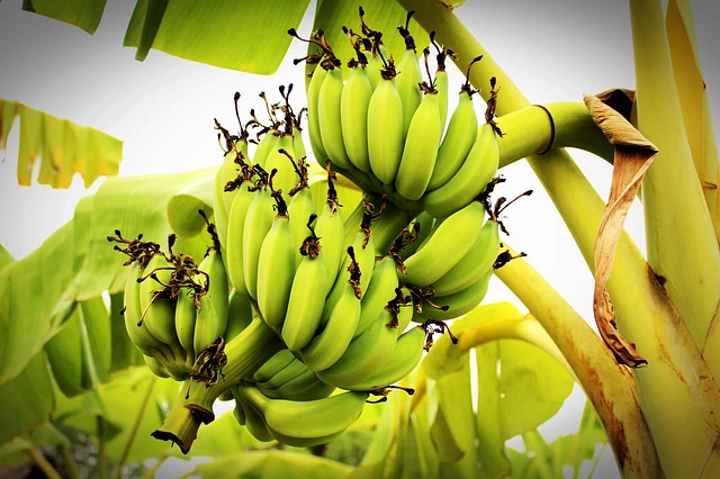
There are small varieties of banana trees suitable for tight spaces
Growing a dwarf banana tree (Musa) is an excellent idea if you have a small garden and want to grow exotic plants. Although botanically speaking, bananas are a type of herbaceous plant, we usually refer to them as trees.
Dwarf banana cultivars only grow to between 4 and 12 ft. (1.5 – 4 m) tall, which is small compared to a traditional banana plant of 50 ft. (15 m). Some of the smaller varieties are well-suited to growing in containers and pots.
Excellent dwarf bananas to grow in pots include ‘Dwarf Cavendish,’ ‘Dwarf Red,’ ‘Gran Nain,’ and ‘Dwarf Lady Finger.’
If you live in tropical zones 9 – 11, a potted banana plant growing on a balcony, patio, or deck can be an excellent talking point. You can also enjoy small, delicious bananas straight from the dwarf fruit tree.
Related articles:
